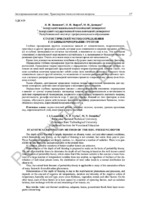| dc.contributor.author | Леонович, И. И. | ru |
| dc.contributor.author | Вырко, Н. П. | ru |
| dc.contributor.author | Демидко, М. Н. | ru |
| dc.coverage.spatial | Минск | ru |
| dc.date.accessioned | 2018-09-18T12:31:20Z | |
| dc.date.available | 2018-09-18T12:31:20Z | |
| dc.date.issued | 2015 | |
| dc.identifier.citation | Леонович, И. И. Статистический метод определения глубины промерзания грунтов / И. И. Леонович, Н. П. Вырко, М. Н. Демидко // Труды Белорусского государственного технологического университета. Серия 2: Лесная и деревообрабатывающая промышленность. – 2015. – № 2. – С. 27-31. | ru |
| dc.identifier.uri | https://rep.bntu.by/handle/data/47635 | |
| dc.description.abstract | Глубина промерзания грунтов в основном зависит от климатических, гидрологических, грунтовых и других природных условий, которые сами изменяются в широких пределах, поэтому и глубина промерзания не остается постоянной, а изменяется из года в год. Эти колебания (изменения) в значительной мере являются случайными, т. е. зависящими от большого числа переменных факторов. Учесть их в явном виде в настоящее время нет возможности. Кроме того, неизвестны возможные колебания в будущем самих метеорологических факторов. Определение глубины промерзания грунтов предлагается производить на основе теории вероятностей. Применение теории вероятности к определению глубины промерзания грунтов основано на известной центральной предельной теореме теории вероятностей, которая гласит, что если случайная величина представляет собой сумму (или линейную функцию) большого числа независимых одна от другой величин, то независимо от законов распределения отдельных частных слагаемых распределение суммарной величины стремится к нормальному закону (или близкому к нему). Таким образом, центральная предельная теорема теории вероятностей применима для изучения суммарного действия многих факторов в многофакторных явлениях. Определение глубины промерзания связано с многофакторными явлениями и процессами и зависит от суммы отрицательных температур воздуха, продолжительности и интенсивности действия отрицательной температуры, влажности и типа грунта, мощности снегового покрова, растительности, рельефа местности и др. С другой стороны, каждый из этих факторов, в свою очередь, обусловлен рядом действующих факторов, например радиационным балансом, теплообменом с воздухом, циркуляцией воздушных масс и т. д. | ru |
| dc.language.iso | ru | ru |
| dc.publisher | БГТУ | ru |
| dc.subject | Водно-тепловой режим | ru |
| dc.subject | Земляное полотно | ru |
| dc.subject | Пучение | ru |
| dc.subject | Уровень грунтовых вод | ru |
| dc.subject | Морозозащитный слой | ru |
| dc.subject | Номограмма | ru |
| dc.subject | Карта изолиний | ru |
| dc.subject | Water and thermal conditions | en |
| dc.subject | Subgrade | en |
| dc.subject | Heave | en |
| dc.subject | Groundwater level | en |
| dc.subject | Frost layer nomogram contour map | en |
| dc.title | Статистический метод определения глубины промерзания грунтов | ru |
| dc.title.alternative | Statistical estimation method of the soil freezing depth | en |
| dc.type | Article | ru |
| local.description.annotation | The depth of soil freezing is largely dependent on climate, water, soil and other natural conditions, which themselves vary widely, so the depth of freezing is not constant, but varies from year to year. These fluctuations (changes) are largely random, i.e., depend on a number of variables. There is no possibility to take them into account explicitly in the present time. In addition, possible variations of future weather factors are unknown. Determination of the depth of soil freezing is proposed to make on the basis of probability theory. The use of probability theory to determine the depth of soil freezing is based on the well-known central limit theorem of probability theory, which states that if the random variable is the sum (or a linear function) of a large number of independent variables from one another, so regardless of the laws of the distribution of individual private terms, the distribution of total value tends to a normal distribution (or close to it). Thus, the central limit theorem of probability theory is applicable to study of the cumulative effects of many factors in the multivariate phenomena. Determination of the depth of freezing is due to the multifactorial phenomena and processes, and depends on the amount of negative air temperatures, duration and intensity of the negative action of temperature, humidity and soil type, snow cover thickness, vegetation, terrain and other factors. On the other hand, each of these factors is in turn caused by a number of operating factors, such as radiation balance, heat exchange with the air and circulating of air masses, etc. | en |

